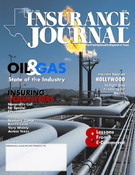The economy is booming. New millionaires are being created every day. American business has never had it so good. So being an insurance agent is the fast track to financial freedom, right? Wrong.
No one is setting up charities for agents just yet, but the industry is on the tail end of the economic wave. Even within the ranks of the agents, there is a sliding scale of growth, profitability and future potential. The smaller the agency, the tighter the financial squeeze.
The long-term soft market has wreaked havoc for the typical agency owner. Commission dollars earned to sell and service accounts have dropped. The problem is the client and the companies expect more and more out of the agents.
Agency profitability has dropped from 25 percent of revenue or more (typical 20 years ago), to a 15 to 25 percent profit margin range, which a typical agency could expect today. The growth in expenses has outpaced the growth in revenue.
The biggest single expense is for personnel, typically costing 52 to 73 percent of revenue. In general, owner and producer compensation is between 25 to 35 percent of revenue, office staff compensation ranges from 20 to 28 percent of revenue, and benefits and taxes cost 7 to 10 percent of revenue. The low unemployment is aggravating the situation.
Automation did not turn out to be the productivity panacea that was expected. How many agencies have cut staffing after they bought a new computer system? Sometimes staff was increased to add on an automation person or data entry person.
Original computer hardware and software probably caused more problems than it was worth. The new systems have finally got their act together and are really good. The only problem is that expectations are higher and both the client and the insurance company expect more work from the agent and staff.
Besides, automation expenses did not exist over 20 years ago. Other expenses are going up as well. Office rent has shot through the roof in many areas. Advertising, supplies, travel and automobiles expenses have all increased.
So can anything be done to help the typical agency owner stop the erosion of profits? The answer is “yes.” Plugging the financial leaks in an agency can add up to sizable savings. When performing an efficiency study, the first step is locating where these leaks exist.
The place to start is with the people doing the work. Employees know what works and what doesn’t work. Manage-
ment’s role is to determine which is the most cost-effective solution, if any.
So, management should ask the employees the following question: “What three things can be done to make your job more efficient?”
Bring the staff together to discuss the suggestions. Brainstorm on the issues. Delegate some of the problem-solving to the staff and have follow-up meetings. The best suggestion should win a reward, perhaps $100 or more depending upon the savings. This process should be repeated annually.
Next, each agency owner/manager should perform their own analysis. The following are some basic areas to explore:
• Is the agency overstaffed?
Compare the agency productivity to peer groups using one of the published benchmark studies. If overstaffing exists, why and what can be done? Get rid of under-performing employees and reward the high performers.
• Is the layout of the office efficient?
Does the staff have to go long distances or are they impeded when accessing commonly used files, copy or fax machines, etc.? Is the office too small? Is the staff working on top of each other? Is there extra space and is the rent too high?
• Does the agency have enough properly functioning and up-to-date office equipment?
Sometimes one extra fax machine can make a big difference in productivity. Is the telephone system efficient?
• Is the staff double-entering data?
This can occur when one person writes down information from a phone call on a piece of paper rather than bringing up the computer screen to complete the transaction, and thus the work is done twice. Or, this can occur when one person takes only some of the information rather than transferring the call to the appropriate person (e.g. claims, Personal Lines CSR or the producer). The client or prospect needs to call back and repeat the same information, making the agency look inefficient.
• Is the agency using transactional filing?
The new software, scanning machines and larger disk space has made this system the way to go on personal lines and perhaps other lines, as well. Agencies with a small commercial accounts department have “T-filed” with success. Unfortunately, many medium to large commercial lines producers still like to carry the client’s file, so old habits are hard to break.
• Does management have a clear direction for the agency and is it communicated to the staff?
Employees need to be pointed in the right direction and told what their purpose is. Having a purpose will prevent the employees from getting bogged down in the minutiae.
• How is the employee morale?
Any number of things can cause poor morale. Often it is related to perceived unequal treatment. Make sure all employees are expected to meet the same high standards. Be consistent with your relationship. The annual performance review is the time to clearly communicate performance expectations and past results.
• Is the staff properly trained?
On-the-job training is a good way to make sure the staff follows agency procedures, but it will perpetuate the same old inefficient ways of working. It’s better to send the employees outside the agency for new ideas when possible. Make sure the staff is kept up-to-date with insurance coverages and procedures. Have the employee inform the rest of the staff on what they learned after they return from the training.
• Does the agency cross-sell on its accounts?
Relationships are strengthened when an agency sells more than one coverage to its clients. Efficiencies are gained by earning more commission per account and spending less time generating the sale since they are already familiar with the firm.
• Does the agency have any program business?
Selling a unique product that is slot-rated can be an incredible income generator. Usually these sales require less work to sell and service. The similarity of the book of business can create high productivity.
• Do the producers pre-screen their prospects?
Pre-screening will help eliminate business that the firm cannot write or should not write. Know the price, product and politics needed to close the sale as soon as possible. It is best to find out the quality of the prospect in the phone call before the visit, than to find out during the marketing process.
• Does the producer or marketing staff selectively approach the firm’s markets or are applications sent out to everyone?
The latter is called the “shot-gunning” or “blocking” of the markets. Sending quotes out to all the markets is a waste of agency time and underwriters’ time. Make sure everyone is aware of which markets will provide the best chance to write the business and limit the amount of quoting. The underwriters will be very grateful and take future business seriously.
• Is the staff sales-oriented?
Not everyone can sell, but everyone should think sales. Sales are the lifeblood of the agency. Everyone should be encouraged to generate leads, even if it is for other departments (e.g. life and health). Use incentives when they do refer these leads and they are successfully written.
Summary
Starting the efficiency study process will take a commitment on the part of all owners, managers and employees. Keep in mind the first step is the hardest. Sometimes it helps to bring in an outside party to get the process started.
Small gains when compounded over time result in enormous savings. The goal is to work smarter not harder. Implementing the ideas that are laid out in this article will take some time, but will change the way you do business forever.
Bill Schoeffler and Catherine Oak are partners in the international consulting firm, Oak & Associates, based in Northern California. The firm specializes in financial and management consulting for national and international insurance agencies, including valuations, mergers, acquisitions, clusters, sales and marketing planning, as well as perpetuation planning. For more information, call (707) 935-6565 or send e-mail to catoak@sonic.net. To view this article online, please visit www.InsuranceJournal.com and click on Sales Tools.
Topics Agencies Profit Loss
Was this article valuable?
Here are more articles you may enjoy.


 How ‘Super Roofs’ Reward Insurers, Cat Bond Investors and Homeowners
How ‘Super Roofs’ Reward Insurers, Cat Bond Investors and Homeowners  Why Reciprocal Insurance Exchanges Are Back in Fashion
Why Reciprocal Insurance Exchanges Are Back in Fashion  Dozens of State Attorneys General Urge Congress Not to Block AI Laws
Dozens of State Attorneys General Urge Congress Not to Block AI Laws  Foundation Firmed: AM Best Switches View of US Homeowners Insurers to Stable
Foundation Firmed: AM Best Switches View of US Homeowners Insurers to Stable 


